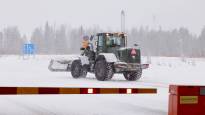The Russian home audience is told about the hostile West and Finland as part of it. The countries’ relations are now being rebuilt.
There is no certainty about Russia’s goals in the border situation, but it is experimenting and testing Finland by creating pressure on the border.
We collected questions related to this situation on the eastern border. They are answered by a Russia expert Hanna Smith (HS) and Network Director of the European Competence Center for Countering Hybrid Threats Jukka Savolainen (JS).
What is Russia aiming for on the eastern border?
HS: There are two things in the big picture. Russia is at war with Ukraine – from Russia’s point of view more broadly against the West – and Finland has joined NATO. The background is that Russia has announced that membership has consequences. The situation on the eastern border is one of the consequences.
JS: Russia can test Finland and see how the chosen method works. At the same time, it is a potential threat. It is shown that the immigration weapon can be used if necessary.
What is the benefit of the situation for Russia?
HS: Russia needs a unified, hostile image of the West that benefits the Russian leadership. Finland has not agreed to this picture before, but now they are trying to build it. The relations between Finland and Russia are at a turning point. The Russians have realized that they don’t know Finland after all. Let’s see who Finland cooperates with and try to stir up discord in Finnish society. Building a new relationship is a long-term process.
Limiting border traffic may serve Russia’s current rulers. At the same time, we can get rid of a few refugees.
JS: In Russia, a castle camp atmosphere can be created from the threat of the West. Finland’s eastern border is becoming a useful confrontational narrative for the Kremlin. When the same story is repeated, the psychological defense mechanism brings even the skeptics behind the mainstream thinking.
How can Finns prepare themselves for inciting discord and influence attempts?
HS: We can try to understand it. Others see the situation as a security issue, others as a refugee issue. There is a danger that the discussion will go beside the point. Radicalization of the camps must be avoided.
Talks about a Russophobic society can drive a wedge into relations between Finns and those living in Finland. Demonstrations that have remained peaceful can be exploited.
JS: If the situation worsens, a disagreement is to be expected. If strong restrictive measures are continued and increased, some people will consider them unreasonable. Finland may be brought into the European debate here, where two extremes are on display. Tight control versus free movement. We should avoid Finland becoming a middleman in the European debate, as well as the petty politics of short-term parties. Patience is needed.
How far can Russia take the situation?
HS: Clearly quite far. This was practiced in 2015–2016. Now the operation is more systematic. Official Russia can decide whether to proceed or not.
JS: If a part of the Earth’s migration flows here, the potential of the new arrivals will be counted in the millions. Then it is difficult to handle the situation. Russia can also decide that it was a temporary disturbance and the situation would end well for Finland. The intermediate form is that actions are aimed at a negotiating position. Discussions can also be held in the future.
Why are there aspirants now on the borders of Finland, but not, for example, on the borders of Estonia?
HS: Russia’s relations with Estonia or Norway have not changed. Finland’s NATO membership is a new thing.
JS: The reasons cannot be known. Some phenomenon now points in the direction of the Finnish border.
How does the situation in Finland differ from the border situation in Poland and Belarus?
HS: In Belarus, there was campaigning and organized flights in the departure countries. This has not been observed so far. The aspirants to Finland seem to have already been to Russia. There are also similarities. We practiced against Finland in 2015–2016, the bigger practice was in Belarus. The leadership of an authoritarian state can benefit if EU countries restrict immigration.
JS: There is a lot of difference. People were gathered from third countries. People were pushed violently to terrain borders and not to crossing points. This was aimed at collapsing the immigration system when immigrants were not under official control. The situation in Finland is significantly better.
Is Russia trying to influence the Finnish presidential election campaigning?
HS: I don’t think so at the moment. The relationship between Finland and Russia is changing in general. The US presidential election campaign talks about Donald Trump as Russia’s preferred candidate, but there is no similar candidate currently running in Finland. Rather, the wishful thinking of Russia’s rulers is that it would perhaps be possible to influence the government’s ability to function and undermine civil society’s trust in decision-makers.
JS: The presidential election candidates do not show any differences here.
Watch the MPs’ discussion of the border situation here:
